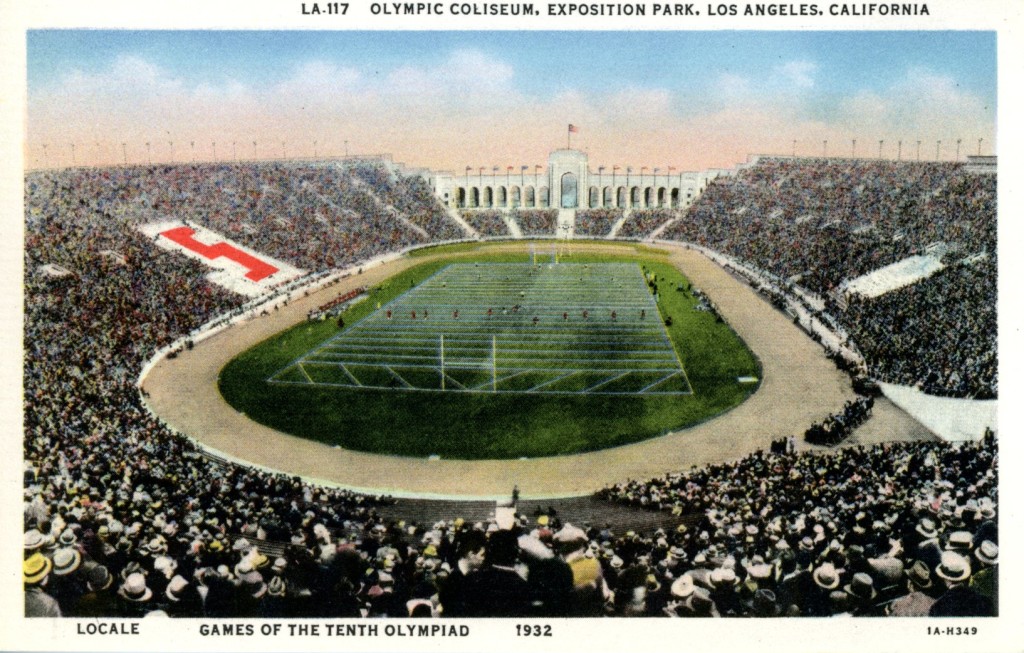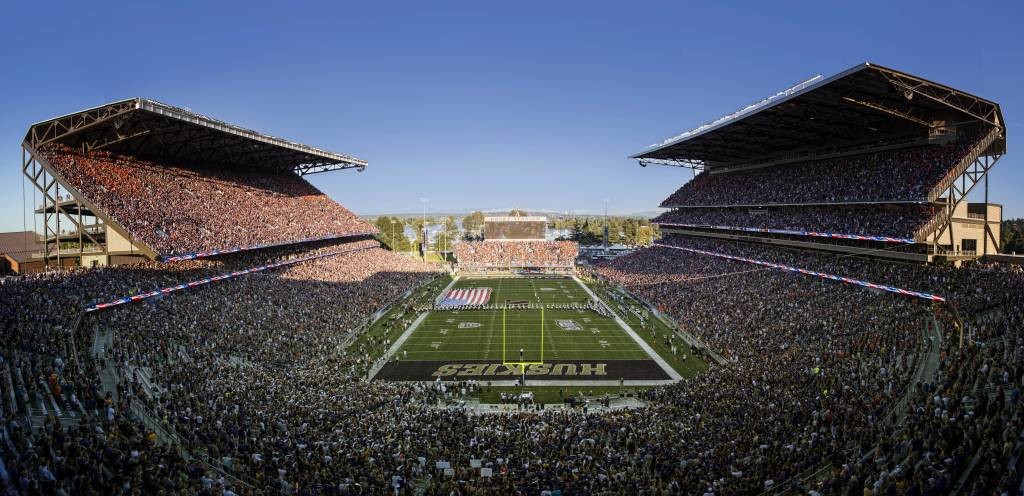It’s fitting, in a way, that the latest NFL franchise to make a move across the chessboard that is North America has landed at the Los Angeles Memorial Coliseum. If ever there was a franchise and a venue so steeped in the history of NFL relocation and the need for temporary stadiums, it’s the Los Angeles Rams and the Coliseum.
The LA Coliseum, occupied by an NFL franchise for the first time since 1994, reclaims its title as the oldest stadium in use in the NFL, having been built in 1921 and first occupied by the same Rams franchise in 1946 that returns 70 years later for a three-year stint, before moving permanently (we think) to Inglewood, Calif.
All three teams involved in relocation talk over the past year – the Rams, Oakland Raiders and San Diego Chargers – once called the LA Coliseum their home. The Rams were there the longest, for 33 years. After the Rams left the Coliseum for Anaheim, the Raiders traveled to SoCal for 12 years, from 1982-1994, much to the delight of Hollywood stars like Jim Rockford himself, James Garner.
And while the Chargers’ destiny did not land them back in LA this season, the Coliseum will always be known for providing the Bolts with their first temporary home as an original AFL franchise in 1960, before moving to San Diego the next year.
But please, this is not just some California thing. Temporary NFL homes have touched virtually every corner of this great land, from the Northeast to Midwest and down South.
When the Rams lace them up at the Coliseum this fall, they will become the 9th franchise since the 1970 AFL-NFL merger to play at least one full season in a home away from home, though there were teams in the pre-merger era that also sought temporary stadiums. Not even the majesty of the Super Bowl has gone unscathed, requiring a relocation of sorts in 1975.
Here then, is an overview of the NFL’s vagabond ways, proving the great novelist Thomas Wolfe wrong. You can go home again.
THE RE-LOCATORS
Give Robert Irsay credit for one thing. When he moved the Colts out of Baltimore in the dead of night in 1984, at least he had a place ready to go in Indianapolis.
For the three franchises who would follow in the Colts’ footsteps over the next 31 years, finding a permanent home in their new surroundings proved just as challenging as cutting the emotional cord with the city they left behind.
In a modest preview of their current status as temporary tenants of the LA Coliseum, the Rams were forced to find an alternative home field in St. Louis for the first four games of their inaugural season in their new home city in 1995.
With the then-named Trans World Dome still under construction when the Rams finalized their move to St. Louis in early 1995, the Rams were forced to play at Busch Stadium, which had once hosted the St. Louis Cardinals football franchise, which itself had re-located to Arizona in 1988.
The Rams’ final home game at Busch on Oct. 22, 1995 was the last game held by an NFL team at the venerable old stadium, which was eventually replaced by a new Busch Stadium in 2006.
The Rams’ relocation to St. Louis was remarkable because it left Los Angeles without any professional football, with the Raiders having abdicated the Coliseum that same year to return to their original roots in Oakland.
But that moved paled to the one that rocked the NFL after that 1995 season, when Art Modell took the Browns out of Cleveland, ripping a gaping hole in the psyche of one city and filling the same void for another.
But while Modell quickly gave the fans of Baltimore a new name – the Ravens – getting a new stadium would take two seasons. What is now known as M&T Bank Stadium would not open its doors until 1998, meaning the new Ravens franchise would return NFL football to Baltimore’s “Old Gray Lady of 33rd St.”, Memorial Stadium. The building that once housed the Colts and its legends Johnny Unitas, Lenny Moore and, in more modern times, Bert Jones, played out its final act before its demolition in 2001 by hosting two Ravens seasons, the last team ever to play in the classic yard that was also the home of the Baltimore Orioles in the pre-Camden Yards era.
The Houston Oilers had neither the history, nor the histrionics, of the Rams and Ravens when Bud Adams relocated the franchise to Tennessee in 1997. Perhaps as the fourth franchise to relocate in four years, the move out of Houston may have lacked oomph, but they more than made up for it by really putting a stamp on the new designation as the “Tennessee” Oilers.
With a new stadium for the Oilers in Nashville not scheduled to be ready until the 1999 season, the team played in two separate home stadiums over their two seasons in limbo.
In their first year in their new state, the Oilers, called the Liberty Bowl in Memphis their home. Their second season of 1998 moved the Oiler a little closer to their eventual Nashville home, Adelphi Stadium, by sharing Vanderbilt Stadium with the Commodores, which played its NCAA games on Saturday. Following the 1998 season, they finally settled at Adelphi Stadium and became the Tennessee Titans.
THE RENOVATORS
Not every NFL team that required a temporary stadium to call home was the result of city relocation. In fact, the majority of NFL teams playing in homes away from homes never really left the neighborhood. Seven teams were forced into temporary housing because their current stadium was either under renovation or was outright replaced.
Two teams, the Chicago Bears and New Orleans Saints, returned to the same stadiums they left after a brief stay elsewhere because of renovations and repairs. When Soldier Field in Chicago underwent a major facelift in 2002, the Bears relocated to Memorial Stadium on the University of Illinois campus for one season.
The Saints were forced out of the Louisiana Superdome for the 2005 season after the horrifying destruction of New Orleans by Hurricane Katrina and the damage – physical, emotional and psychological – that hit the citizens who endured the horror of the domed stadium’s occupancy during the disaster.
The Saints split their seven home games that season between Tiger Stadium on the Baton Rouge campus of LSU and the Alamodome in San Antonio before making a triumphant return to the repaired Superdome for the 2006 season.
Five other teams bode their time while new stadiums were built in their cities.
The Cincinnati Bengals debuted as an AFL franchise in 1968 by playing two seasons at the University of Cincinnati’s Nippert Stadium while Riverfront Stadium completed construction for the 1970 season. Another expansion team, the Carolina Panthers, played their inaugural season of 1995 at Clemson’s Frank Howard Field before their permanent home, Ericsson Stadium, opened in 1996.
The New York Giants were forced to do some creative relocating for three seasons between 1973-75, caught between the construction of Giants Stadium in New Jersey’s Meadowlands and the renovation of their longtime home, Yankee Stadium, which closed in 1973 and didn’t re-open until 1976.
For two years, the Giants played their games in Connecticut, inhabiting the venerable Yale Bowl in New Haven, before foreshadowing Meadowlands history by sharing Shea Stadium with the Jets in 1975. The Yale Bowl era included an iconic overtime battle against those Jets, with the image of a hobbled Joe Namath running in a naked goal-line bootleg for the touchdown to force overtime, gesturing plaintively with his free hand as he crossed the goal line to not get hit, lest his game, yet broken-down body take any extra punishment.
In the 21st century, two teams went the college route while waiting out construction of new stadiums in their cities. The Seattle Seahawks brought the 12th man to the campus of the University of Washington for the 2000 and ’01 seasons while Qwest Field (now CenturyLink) was built across the way from Safeco Field. And then there were the Minnesota Vikings, who famously played one game at the University of Minnesota’s TCF Bank Stadium late in the 2010 season after the Metrodome’s roof collapsed after a heavy snowfall, then played two full seasons there in 2014 and ’15, before the opening of its new facility, U.S. Bank Stadium, later this year.
The last game played at TCF Bank Stadium will live in Vikings lore for mostly the wrong reasons after Blair Walsh’s missed field goal cost the Vikings a playoff victory over the Seahawks. But by playing that game at TCF, the Vikings became the only one of the 10 teams to play a season in a temporary stadium to actually make the playoffs.
THE SUPER SECOND HOME
The Vikings, the postseason and a replacement stadium. Never a good combination. For a league so famous for temporary homes, it made sense that even the NFL’s crown jewel event was not immune. From its earliest years, the Super Bowl called New Orleans one of its premier sites, after debuting at – you guessed it – the LA Coliseum in January, 1967.
New Orleans’ Tulane Stadium was the site of Super Bowl IV in 1970, as was Super Bowl VI. The city was then awarded Super Bowl IX, to be played in January, 1975, and it was to be among the first events ever held at the Louisiana Superdome.
But construction delays made it apparent by early 1974 that the Superdome would not be ready to host the game, forcing the NFL to once again turn to an aging Tulane Stadium to host the big game. And as fate would have it, Jan. 12, 1975 was a domed stadium’s delight — a cold, rainy and windy day in New Orleans that became the worst weather for a Super Bowl until the Colts and Bears slogged it out in rainy Miami in 2007.
And those Vikings? It was their third trip to the Super Bowl, and thanks to a suffocating Pittsburgh Steelers “Steel Curtain” defense, it became their third Super loss, 16-6.


